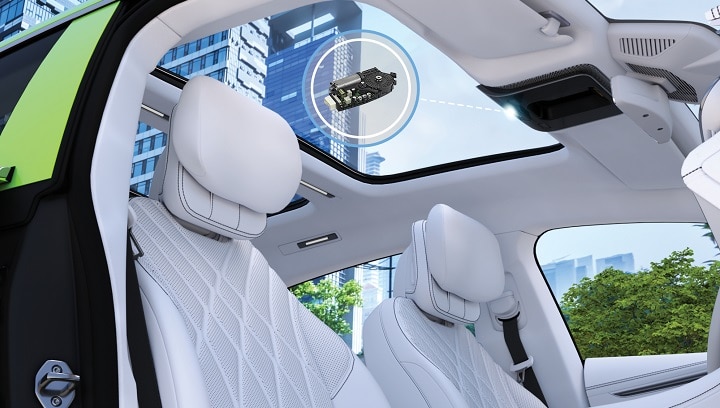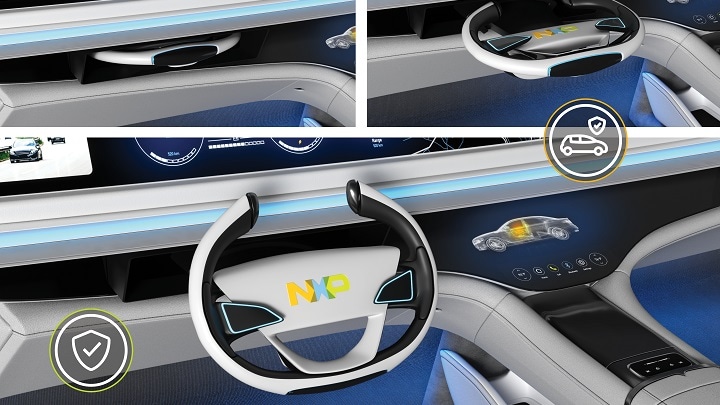News
NXP Expands S32 Platform with Motor Control Solution for Software-Defined Vehicle Edge Nodes
08/11/2023- Made for motor control, NXP’s S32M2 maximizes software re-use across the S32 vehicle compute platform and supports the automotive industry’s transition to software-defined electric vehicles
- OEMs are turning to smaller, lightweight and more efficient BLDC/ PMSM motors, contributing to energy savings and range extension of electric vehicles
- The highly integrated S32M2 simplifies and optimizes motor control of body and comfort applications, reducing in-cabin noise and enhancing occupant comfort
 The purpose-built motor control solution is optimized for efficiency improvement across vehicle applications such as pumps, fans, sunroof and seat position, seat belt pretensioners, trunk openers and more.
The purpose-built motor control solution is optimized for efficiency improvement across vehicle applications such as pumps, fans, sunroof and seat position, seat belt pretensioners, trunk openers and more.DETROIT, Nov. 07, 2023 (GLOBE NEWSWIRE) — NXP Tech Days — NXP Semiconductors N.V. (NASDAQ: NXPI) expands its scalable S32 vehicle compute platform with the introduction of the S32M2. The purpose-built motor control solution is optimized for efficiency improvement across vehicle applications such as pumps, fans, sunroof and seat position, seat belt pretensioners, trunk openers and more. Building on the success of the S12 MagniV® portfolio, the S32M2 combines NXP’s motor control heritage and the software development benefits of the S32 platform. The highly integrated system-in-package solution adds the power and analog functions as well as extensive software libraries required for motor control to NXP’s widely adopted S32K microcontrollers. It addresses the needs of the emerging software-defined electric vehicle market and enables carmakers to fully optimize product development and to maximize software re-use across S32 platform implementations.
Among the many types of electric motors, brushless direct current (BLDC) and permanent magnet synchronous (PMSM) motors are known for their endurance and robustness, small size, low weight and high efficiency, which all contribute to energy savings and range extension for EVs. The S32M2 enables simplified and more robust motor control functions that can run efficiently while maintaining performance headroom to integrate more functions and capabilities while optimizing costs. OEMs can perform motor diagnostic tests, transmit data to the zonal controller and optimize for higher performance to improve efficiency further and lower audible noise in the final application, which improves occupant comfort. Compared with discrete motor control implementations, the S32M2 enables OEMs to accelerate time-to-market and reduce the printed circuit board footprint, design risks and bill-of-material cost.
“By using NXP’s Model-Based Design Toolkit, automakers can start Simulink simulation early in the development cycle and map the model to the S32M2 hardware. Since this is a purely software-defined approach, automakers can optimize software re-use across the S32 vehicle compute platform, while benefiting from feature and performance enhancements which builds on the success of today’s S12 MagniV portfolio.”
Manuel Alves, Senior Vice President and General Manager of General Purpose and Integrated Solutions (GPIS), Automotive Processing, NXP

With the addition of the S32M2, NXP’s S32 vehicle compute platform is consistent from top to bottom, while benefitting from the vast Arm® software ecosystem. The close and long-standing partnership with Arm and previous joint development efforts allow NXP to leverage the full potential of the Arm Cortex™-M processors in terms of power efficiency and safety capabilities in combination with the new motor control solution.
“Vehicle architectures are changing significantly to meet the requirements of a software-defined future. By leveraging the efficient, low-power heritage of the Arm Cortex-M portfolio alongside Arm’s extensive software ecosystem, NXP’s S32M2 product is primed to power the safety-critical, real-time response requirements of edge applications in SDVs while enabling customers to focus their time on product differentiation rather than rewriting code.”
Dipti Vachani, SVP and GM, Automotive Line of Business, Arm
Based on the system-in-package approach, the S32M2 combines advanced compute with MOSFET gate drivers, physical layer interfaces for CAN FD and LIN communication, and a built-in voltage regulator directly from the vehicle’s 12-volt battery, addressing various motor control applications.
Integrating either an Arm Cortex-M4 or Cortex-M7 core, the S32M2 series covers a broad range of memory options from 128KB to 1MB. These devices are supported with the 64-pin LQFP package, which gives automakers the flexibility to select across different memory sizes while having pin-to-pin compatibility within the same family. The system-in-package solution also leverages the S32K’s development processes certified to ISO 26262 for ASIL B functional safety, the S32 platform’s proven security subsystems (CSEc, HSE), and the S32K’s comprehensive tools and software ecosystem.
For more information, please visit http://www.nxp.com/S32M.
-
22/08/2023
FG23 Wireless Sub-GHz SoC
Silicon Labs’ wireless sub-GHz SoC enables Amazon Sidewalk, mioty, Wireless M-Bus, and Z-Wave Silicon Labs’ FG23 is the industry’s first wireless sub-GHz SoC with an Arm® Cortex®-M33, a dedicated security core and Arm PSA3 certification. The device improves on the leading RF performance of Series 1 and now enables 10+ year coin cell battery operation. The […]
-
23/08/2023
STEVAL-IDS001V3, Demonstration Board based on the SPIRIT1 Low data-rate, short-range USB dongle transceiver in 433-MHz band
Description STEVAL-IDS001V3, Demonstration Board based on the SPIRIT1 Low data-rate, short-range USB dongle transceiver in 433-MHz band. The STEVAL-IDS001V4 demonstration board is based on the SPIRIT1, which is a sub-GHz low power, low data-rate transceiver suitable for ISM bands and Wireless M-BUS. The board is equipped with an STM32L low power microcontroller to control the […]
-
22/08/2023
Silicon Labs xG28 Now Available; Helping Customers Like Chamberlain Group and Honeywell with Long-Range Applications at the Edge
In June, we announced our dual-band FG28 SoC, designed for long-range networks and protocols like Amazon Sidewalk, Wi-SUN, and other proprietary protocols. Today, we’re excited to share that the FG28 is now generally available through Silicon Labs and our distribution partners. Learn more about the dual-band FG28 SoC here. We’re also extending our xG28 family of SoCs with the ZG28, […]
-
31/07/2023
FG25 Sub-GHz SoC Now Available for Smart Cities and Long-Range Deployments
During our Works With 2022 Developer Conference, we announced our new flagship sub-Ghz SoC, the FG25, and today we are pleased to announce that it is generally available through Silicon Labs and our distribution partners. The FG25 is the ideal SoC (system on chip) for long-range, low-power transmissions, capable of broadcasting up to 1.6km with minimal data […]
-
31/07/2023
Smart City Living Lab Series: Making Hyderabad, India a Smarter City with Wi-SUN
Specifically designed for smart cities, Wireless Smart Ubiquitous Network (Wi-SUN) is a protocol for low-power Internet of Things (IoT) mesh networks. With its scalability, security, interoperability, and support for a wide range of existing and emerging apps, Wi-SUN is an excellent foundation for sustainable city operations and, ultimately, better quality of life for residents. Cities around […]
-
27/07/2023
Smart City Living Lab Wi-SUN FAN 1.1 Mesh Deployment – Phase 2
As part of the ongoing blog series on the Smart City Living Lab at IIIT Hyderabad, this second post will delve deeper into the details of the inner workings of the state-of-the-art Wi-SUN-enabled Smart City Living Lab. The lab, which stands as a testament to the immense potential of IoT in daily life, mirrors a Smart City on […]
